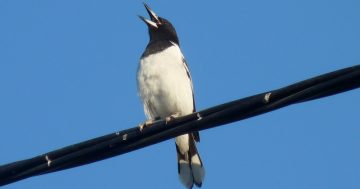
Snipe feed in mud submerged in water. Photo: Ian Fraser
By the middle of August, Canberra is starting to feel a little bit springy for those who keep their eyes, ears and noses open to such things.
Depending on rain, temperatures, frosts, etc, the early wildflowers will be appearing and some of the first migrant birds will be making an appearance. Among these is the greatest traveller of all, a small bird which makes an annual round trip of some 20,000 kilometres to spend our summer in the wetlands of eastern Australia, including Canberra and the ACT mountains.
Latham’s Snipe is a wader, subtly and beautifully streaked in browns and creams with dark scallops and a long straight bill for poking into mud. It is only about the size of a Blackbird, which makes its incredible feats of endurance during its migration even more remarkable.
It breeds in the brief sub-Arctic summer, in meadows and clearings in fir forests of northern Japan and adjacent Siberia. Then, in late July, the first snipe start heading south. As soon as their chick-rearing duties are done they start eating very seriously indeed to build up reserves for the journey. They gorge until the fat layer stretches the skin tightly across their body and they can barely take to the wing.

Latham’s Snipe plunges its bill deep into the mud, detecting food items by touch alone. Photo: Ian Fraser.
Like many coastal waders some snipe may follow the shoreline of eastern Asia, using the bays and estuaries to feed as they travel, but there is little evidence of this.
Most apparently head due south from Japan over the Pacific, flying some 7000 km over open ocean without feeding or resting for about three days until reaching the coast of New Guinea – that works out to a steady 95 km/h non-stop for the three days.
Once there they fly over the forbidding New Guinea ranges and don’t rest until they reach Australia, where they spread out all along the east coast, as far south as Tasmania. And after a summer of feeding and mostly taking it easy here, they fly back the same way in autumn to where their Japanese breeding grounds are now thawing out.
And how do we know this? There have been indications from observers seeing them leaving Japan and then arriving in northern Australia, but more accurately some of them now bear tiny transmitters which allow them to be tracked.
The Latham’s Snipe Project is a joint Australian-Japanese effort, with funding from the Australia Japan Foundation and the ACT government, and input from many ‘citizen scientists’ who assist in annual surveys to learn how many snipe there are in different areas and where they go in Australia.
The two key sites being targeted are Jerrabomberra Wetlands in eastern Canberra and Port Fairy in south-west Victoria.
In the past some people were challenged by the fast swerving flight of the birds when disturbed, and found entertainment in shooting them in flight.

A snipe’s eyes are set so far back on the sides of its head that it can see behind it! Photo: Ian Fraser.
In fact the original ‘sniper’ was someone who shot snipe in such a way. It is estimated that some 10,000 snipe were legally shot in Australia every year before the practice was finally banned, state by state, in the 1980s.
Snipe hunting in Japan was stopped in 1974. Now the main danger to their future is from habitat loss and while it is very difficult to get accurate figures, it seems that numbers are still falling, especially after prolonged drought and widespread recent fires in Australia.
The Latham’s part of the name is a bit of a mystery. John Latham was an eminent English ornithologist around the end of the 18th century, but his connection with the bird is very tenuous and no-one seems to know how the name came to be or why it stuck.
Some years ago I co-wrote a book on the origins of Australian bird names and this was one of our few failures!
The best way to see the snipe is from the hides at Jerrabomberra, especially when it’s quiet in the early morning or evening. Get your eye in – their camouflage is excellent, but they’ll move eventually and may even approach quite closely if you’re quiet and still.
While they’re busy plunging their bill up and down in the mud like a sewing machine needle, searching for small animals, they can be quite oblivious to us. The accompanying photos were taken in that way at Jerrabomberra.
The bird is the subject of a conservation treaty between Australia and Japan. As I watch the snipe feeding, with the parliament that ratified the treaty in the background, I again think how lucky we are to live here. Especially with spring coming.
Ian Fraser is a Canberra naturalist, conservationist and author. He has written on all aspects of natural history, advised the ACT government on biodiversity and published multiple guides to the region’s flora and fauna.





















